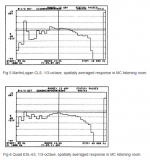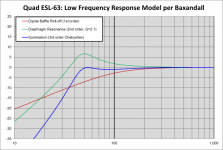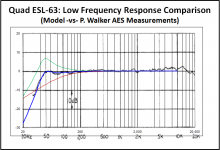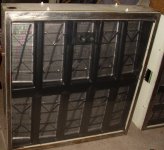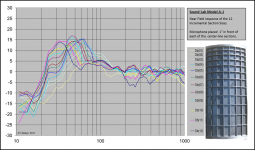In the various threads here on making ESL panels one common theme is that the panel resonance defines a low end cutoff for the usable frequency response of the speaker. (That and the saturation of the transformers, the d/s etc.) In making several panels myself, the lowest I could get the resonance and have the panel work reasonably well was in the 60-65 Hz range.
How is it that Martin Logan, Acoustat and others can produce a full range panel? I have a pair of ML CLSII that have a fairly smooth response down to about 30Hz. Nowhere in the electronics do I see a notch filter for the resonant frequency of the panel. Is it Judicious spacing of the damping tape, the curve of the panel, or something else?
How is it that Martin Logan, Acoustat and others can produce a full range panel? I have a pair of ML CLSII that have a fairly smooth response down to about 30Hz. Nowhere in the electronics do I see a notch filter for the resonant frequency of the panel. Is it Judicious spacing of the damping tape, the curve of the panel, or something else?
I don't know anything about ESL panels, but the idea that Fs limits useable bandwidth is common with cone speakers also, but it's not true. A voltage source amplifier doesn't care about speaker resonance, but tube amps might have trouble. The impedance spike would mess up crossover filter, but you are full range.
Quad uses 4-6 smaller panels rather than single large panel like Martin Logan, so Quad's panel Fs should be higher. But they play <40Hz without any problem.
Quad uses 4-6 smaller panels rather than single large panel like Martin Logan, so Quad's panel Fs should be higher. But they play <40Hz without any problem.
In the various threads here on making ESL panels one common theme is that the panel resonance defines a low end cutoff for the usable frequency response of the speaker….In making several panels myself, the lowest I could get the resonance and have the panel work reasonably well was in the 60-65 Hz range. How is it that Martin Logan, Acoustat and others can produce a full range panel?
You are correct that the fundamental resonance of an ESL panel defines its useful low frequency limit. Near field acoustic output will fall -12dB/oct below resonance with frequency independent voltage source driving the stators. This is similar to the behavior of dynamic woofer in sealed enclosure. Far field response will most likely have an additional -6dB/oct roll off increment from dipole cancellation, again similar to a dynamic dipole.
With dynamic drivers, you adjust resonance by varying moving mass and suspension stiffness. With ESL diaphragms being so light, the moving mass is defined by the airload which is roughly proportional to area. For ESL diaphragms of a given area, you can adjust resonance by varying tension and unsupported width. If you are after resonance ~ 30hz, I would suggest using minimal mechanical tension(or heat shrink tension) and unsupported widths of 6” to 10”. Be aware that if you want to have useful(+95dB) output down at 30hz you will need large area as your excursion is generally limited to 1/16” – 1/8”.
One other option is to use a large unsupported width which results in extremely low resonance and perhaps diaphragm instability and sticking to the stators. Then, start adding silicone or foam tape "dots" spaced down the middle of the panel until you achieve the resonance you are after.
Acoustat and QUAD apply acoustic damping to keep the LF response around resonance from being too peaky. Acoustat used thick felt pads spaced down the center of the panel. QUAD used/uses silk screen mesh attached to the inside of the stators. Martin Logan did not use any damping on their CLS that I am aware of. See the attached published response curves comparing the LF behavior between CLS(undamped) and QUAD ESL63(damped).
I posted measurements showing damping effectiveness of felt and silk screen mesh here:
http://www.diyaudio.com/forums/plan...con-dots-resonance-control-3.html#post1958582
Also, be aware that with low tension, resonance frequency will decrease noticeably as bias voltage is increased.
Details here:
http://www.diyaudio.com/forums/plan...agm-resonance-change-hv-bias.html#post1884466
http://www.diyaudio.com/forums/plan...rrent-vs-voltage-drive-esl-7.html#post2366501
Attachments
Last edited:
Hi,
Open electrostatics like the Quad use a high Q panel resonance
to obviate the baffle loss of an open baffle and the end result
is inevitably pretty poor low bass power handling.
The manipulation is all acoustic / mechanical, and you won't
see it in the circuitry. But it is still there and has serious
consequences to the nature of the bass capabilities.
e.g. a ELS57 can't do bass louder than an a LS3/5A.
All FR electrostatics have relatively very restricted bass SPL,
but can go low, unfortunately not very loud in any sense.
rgds, sreten.
Open electrostatics like the Quad use a high Q panel resonance
to obviate the baffle loss of an open baffle and the end result
is inevitably pretty poor low bass power handling.
The manipulation is all acoustic / mechanical, and you won't
see it in the circuitry. But it is still there and has serious
consequences to the nature of the bass capabilities.
e.g. a ELS57 can't do bass louder than an a LS3/5A.
All FR electrostatics have relatively very restricted bass SPL,
but can go low, unfortunately not very loud in any sense.
rgds, sreten.
Last edited:
Also, we are always talking open baffles - that alone limits the bottom end.
Having said that (and with all the cautionary thoughts in previous posts), the Dayton-Wrights achieve pretty good bass to maybe 50 Hz - which sounds a whole lot better to your ears than you'd imagine from hearing people talking about systems that go to infrasonics.
But these speakers are very large, can eat tremendous power, are filled with welding gas (which has a whole bunch of good consequences for bass), and have 39 lb transformers. And some models need augmentation in the tweeter end.
As a fan of ESLs, I wonder if ESL concept can take a better shot at being full-range output (and dispersed, etc.) than trying to make a single cone driver do it. Of course, headphones manage the trick pretty well with single cone-like drivers (albeit in a more benign acoustic setting).
Ben
Having said that (and with all the cautionary thoughts in previous posts), the Dayton-Wrights achieve pretty good bass to maybe 50 Hz - which sounds a whole lot better to your ears than you'd imagine from hearing people talking about systems that go to infrasonics.
But these speakers are very large, can eat tremendous power, are filled with welding gas (which has a whole bunch of good consequences for bass), and have 39 lb transformers. And some models need augmentation in the tweeter end.
As a fan of ESLs, I wonder if ESL concept can take a better shot at being full-range output (and dispersed, etc.) than trying to make a single cone driver do it. Of course, headphones manage the trick pretty well with single cone-like drivers (albeit in a more benign acoustic setting).
Ben
Last edited:
Ah, Dayton-Wrights! It was a pair of XG-8s an audio reviewer friend had in the 70s that turned me into a stat freak. The Hi Fi Shop I worked at during college picked up line selling the MKIII at the time.Having said that (and with all the cautionary thoughts in previous posts), the Dayton-Wrights achieve pretty good bass to maybe 50 Hz...
Inhaling SF6 can be fun as it has the opposite effect of helium on your voice.But these speakers are very large, can eat tremendous power, are filled with welding gas (which has a whole bunch of good consequences for bass), and have 39 lb transformers. And some models need augmentation in the tweeter end.
Ever heard a big Sound Lab stat? My U-1s measure flat to 30 hz in my room and don't suffer the top end limitation of the Daytons as they use two overlapping toroidal transformers. They also make double diaphragm electrostatic subwoofers.As a fan of ESLs, I wonder if ESL concept can take a better shot at being full-range output (and dispersed, etc.) than trying to make a single cone driver do it.
They take a different approach on dispersion. While the D-Ws arrayed the 8-10 panels in somewhat of an arc, The SL has a single diaphragm with a lattice that controls directivity. There are lots of flat facets varying in height across an arc. There are 22 degree, 45 degree and 90 degree models. The only exception is the subwoofer which is flat across. Some like mine have metal frames.
With controlled dispersion, they are designed to be used in arrays for more output and coverage. Google "Soundlab Ray Kimber" to see the two and three set arrays he used to take to shows. Yes, those really are nine feet tall.
WOW Estat Has got it going on....
My U-1s measure flat to 30 hz in my room and don't suffer the top end limitation.
I just put the New toroidal transformers...... SoundLab M1 for a guy i do tube work for....I myself have had the older SL A1.......like driveing a dead short!
M1s top end is still not even as good as my old moded Acoustats M3s....M1s Bass great 25-30hz ezey....but the top sounds like 15k at best.....SL M1 are out of the guys setup less the trany change with a littel time...........
King sound ESL are so ezey to drive an the topend is the best of any ESL.......there twoways with tweeter an bass.........
An the SL M1s have to be driven with $50k in amps an frontend.....these M1 are in a room 25'X30'.....
Sounds like your SL are some real keepers....
good luck
My U-1s measure flat to 30 hz in my room and don't suffer the top end limitation.
I just put the New toroidal transformers...... SoundLab M1 for a guy i do tube work for....I myself have had the older SL A1.......like driveing a dead short!
M1s top end is still not even as good as my old moded Acoustats M3s....M1s Bass great 25-30hz ezey....but the top sounds like 15k at best.....SL M1 are out of the guys setup less the trany change with a littel time...........
King sound ESL are so ezey to drive an the topend is the best of any ESL.......there twoways with tweeter an bass.........
An the SL M1s have to be driven with $50k in amps an frontend.....these M1 are in a room 25'X30'.....
Sounds like your SL are some real keepers....
good luck
Understand that Dayton-Wrights from the XG-8 MKII forward used a piezo tweeter to extend HF response. My friend's MKIs were a bit polite on top. I can't say that the SLs are flat to 20 khz, but they don't need a supplemental driver either - especially with the Toroid II trannies. I find there's precious little musical content up in the belfry. My 1+1s don't sound quite as pure on top, although they're now getting updated by Roy Esposito and I suspect they will return better in that respect. I opted for the "air" mod.WOW Estat Has got it going on....
My U-1s measure flat to 30 hz in my room and don't suffer the top end limitation.
Somehow I manage with 2001 VTL MB-450s that ran only $10k (call it 12 with aftermarket cords) in a 15'x26' room.An the SL M1s have to be driven with $50k in amps an frontend...
Measured in room response curve showing third octave smoothing:
An externally hosted image should be here but it was not working when we last tested it.
Most ESLs which do not use resistive damping have diaphragm resonances with Q of 10 – 20. By comparison, Quad damped their resonance to the point where it could effectively be used to equalize the bass response flat. The attachments show the ESL-63 LF modeling based on parameters provided by Baxandall and comparison with measurements published by P. Walker in his AES paper.Open electrostatics like the Quad use a high Q panel resonance
to obviate the baffle loss of an open baffle and the end result is inevitably pretty poor low bass power handling. The manipulation is all acoustic / mechanical, and you won't see it in the circuitry. But it is still there and has serious consequences to the nature of the bass capabilities.
The bass capability (SPL at a given frequency) is defined purely by the volume displacement (area x excursion capability). It doesn’t matter whether the motion of the diaphragm comes purely from the electrostatic driving force, or partially from Q “amplification” of that driving force. For comparison with dynamic drivers simply compare volume displacement capability. With D/S spacings of only 1.5mm – 2.5mm, typical ELSs need to have roughly 10x to 20x the area of a dynamic driver to have the same LF output capability. For example, a single 10” woofer would have similar bass capability to the ESL-63 when mounted on the same sized dipole baffle. A modern 10" woofer in a sealed enclosure would easily outperform the ESL-63 in bass output capability.
@bentoronto,
Any idea on the total area and excursion capability of your Dayton-Wright ESLs?
Attachments
Pardon the intrusion, but I can answer part of your question. And the answer derives differently from any other electrostat (among many) that I have experienced. As for area, there are two answers. Huh? The Dayton-Wright design employed either eight or ten panels (four or five stacked) in the cabinet. Attached is a pic of a later ten panel XG-10 version.@bentoronto,
Any idea on the total area and excursion capability of your Dayton-Wright ESLs?
What you may not notice is there are two diaphragms. The one on the panel and the second one that covers the entire surface of the cabinet. Why? The design incorporates the usage of sulphur hexafluoride gas to lower the resonance and provide additional power handling. In other words, the panels lived in a box sealed with another mylar diaphragm filled with electrical insulating gas. Consequently, the radiating area for bass response is that of the outer diaphragm, not the sum of the multiple panels. The answer is about nine square feet. If you're interested, here's a link to a more comprehensive description.
SF6 gas exhibits the opposite characteristics of helium being heavier than air. If you put some of the gas into a cup, it would settle at the bottom, but it was colorless. If you put your finger in the cup, you could feel the gas present. I was present when a reviewer friend replaced a panel. That process necessarily meant puncturing the outer diaphragm as the initial step. After replacing the panel proper, the outer mylar was sealed using mylar packing tape and the cabinet was re-pressurized with SF6 gas. The funny part is my friend is a baritone in a major city symphony chorus. He sung part from an operatic piece that sounded like Lurch at The Met.
The Dayton-Wright was an incredible design that incorporated truly unique aspects. Unfortunately, it suffered a bit in response at the lowest and upper most octaves. But what it did was simply glorious. Nelson Pass demoed his Threshold amplifiers in the early 90s using a stacked pair of double Daytons - which have the radiating area of the larger current Sound Lab stats.
Attachments
Bolserst, Maybe this is a dumb question and will only further establish my ignorance in this area... When you speak of resistive damping, are you referring to an electrical compensation (i.e. a resistor along with the inductance of the transformer and capacitance of the panel) or a physical damping material on the stators or diaphragm?
When you speak of resistive damping, are you referring to an electrical compensation (i.e. a resistor along with the inductance of the transformer and capacitance of the panel) or a physical damping material on the stators or diaphragm?
Sorry for the ambiguity
I should have said resistive acoustic damping.
Usually this is in the form of a fine cloth mesh or felt attached to the stator.
In case of the Quad ESL-63 it is a fine silk screen mesh attached to the inside of the rear stator.
For more details on effects of acoustic damping, see the first link in post#3 on the subject.
And note that Dr. West of Sound Lab takes a different approach from the methods you mentioned.For more details on effects of acoustic damping, see the first link in post#3 on the subject.
The panel facets vary in height from top to bottom to distribute the inherent diaphragm resonance.
Distributed Resonance details
Hi,
after my tests the dimensions of the segments must differ considerably, hence their´s Fs must differ considerably, to give an noticeable spread and reduction of the combined Fs.
Also, the segment with the lowest Fs will determine the maximum output, thereby sacrificing on efficiency.
As so often the "revolutionary patented principle" works on paper much better than in reality.
The outrageous claims are mainly marketing-BS.
The base drumhead resonance is not ´killed´ but just slightly broadend, and the acoustic phase cancellation still takes place, it´s effect also just slightly reduced.
If the principle functioned as claimed, the anyhow low efficiency of the panel would drop into the cellar for the low bass.
As efficiency is the most prominent parameter for a good ESL design, draw Your own conclusion
There are only two measurements against that problem:
1) electronic equalisation - most precise, doesn´t really counter the long decay on the panel´s Fs
2) (frequency dependant) resistive damping - not very precise, nearly impossible to achieve the desired frequency dependance, counters the long decay quite well
The second point is what Bolserst described and tested.
The silkscreen mesh obviously introduces a considerable amount of LF-damping and seems acoustically transparent at higher frequencies.
jauu
Calvin
after my tests the dimensions of the segments must differ considerably, hence their´s Fs must differ considerably, to give an noticeable spread and reduction of the combined Fs.
Also, the segment with the lowest Fs will determine the maximum output, thereby sacrificing on efficiency.
As so often the "revolutionary patented principle" works on paper much better than in reality.
The outrageous claims are mainly marketing-BS.
The base drumhead resonance is not ´killed´ but just slightly broadend, and the acoustic phase cancellation still takes place, it´s effect also just slightly reduced.
If the principle functioned as claimed, the anyhow low efficiency of the panel would drop into the cellar for the low bass.
As efficiency is the most prominent parameter for a good ESL design, draw Your own conclusion
There are only two measurements against that problem:
1) electronic equalisation - most precise, doesn´t really counter the long decay on the panel´s Fs
2) (frequency dependant) resistive damping - not very precise, nearly impossible to achieve the desired frequency dependance, counters the long decay quite well
The second point is what Bolserst described and tested.
The silkscreen mesh obviously introduces a considerable amount of LF-damping and seems acoustically transparent at higher frequencies.
jauu
Calvin
I arrive at a different conclusion since the most important parameter to me is audible performance. Theory works only to a point.As efficiency is the most prominent parameter for a good ESL design, draw Your own conclusion.
That includes: high resolution, wide bandwidth, and controlled directivity over a wide area. Two hundred watt amps drive SLs quite well.
after my tests the dimensions of the segments must differ considerably, hence their´s Fs must differ considerably, to give an noticeable spread and reduction of the combined Fs....The base drumhead resonance is not ´killed´ but just slightly broadend, and the acoustic phase cancellation still takes place, it´s effect also just slightly reduced.
With 12 incremental section sizes, the SL A-1 shows a spread of resonance frequencies of a bit over an octave. You are correct that the resonance is not ‘killed’, rather each section has its response broadened and usefully lowered in Q to somewhere between 2(small sections) and 5(big sections). The resulting overlays are a visual mess and it seems unlikely that a desirable bass response would result. But, measured response at the listening position is flat in the bottom two octaves. As Estat mentioned, the audible performance is surprisingly good…especially after seeing the measurements. Plucked and bowed string bass is reproduced well, which usually gives FR ESLs with high-Q resonances fits. (Audiostatics are a perfect example of this)
This is one of the things that troubles the engineer in me about the distributed resonance technique. For example, between 25Hz-35Hz, less than 1/3 of the total panel area is producing useful output. For constant SPL, volume displacement needs to increase by a factor of 8 each time frequency is halved below the dipole cancellation frequency. With only 1/3 of the panel area producing at the lowest frequencies, the D/S spacing must be increased substantially to allow the required diaphragm motion needed when only 1/3 of the panel area is used. This in turn requires increasing the bias voltage and transformer step-up ratios to keep efficiency at a useful level. I much prefer using a single resonance frequency and acoustic damping. This ensures the entire panel area provides useful output at the lower bandwidth limit. This allows the use of smaller area panels and lower D/S spacing for the same SPL output.Also, the segment with the lowest Fs will determine the maximum output, thereby sacrificing on efficiency.
Note also that the improvement in LF output from resonance is not enough to completely equalize the roll off due to dipole cancellation. SL uses a similar setup to Acoustat where the output from a LF transformer with a higher step-up ratio is mixed with the output from a HF transformer.
Example SL interface circuit posted here:
http://www.diyaudio.com/forums/planars-exotics/254723-acoustat-mk-series-2.html#post3911097
Example Acoustat mixer response posted here(SL is very similar):
http://www.diyaudio.com/forums/plan...cls-ii-stators-best-way-do-2.html#post3822064
Dr. West of Sound Lab takes a different approach from the methods you mentioned.
Note that the Sound Lab patent claims on distributed resonance were cancelled in 1994 when the patent was rexamined. See the last page of patent US5054081.
Perhaps it was discovered that Magnepan's 1972 patent (US3674946) already taught the technique of distributed resonance for planar ribbons. See Figure 12 & 13 for details of diaphragm sectioning and resulting distributed resonances. Applying the concept to ESLs, perhaps, was not deemed novel enough to warrant a patent.
If interested, I had previously posted these patents here:
http://www.diyaudio.com/forums/planars-exotics/203990-esl-woofer-anybody-game-12.html#post2887548
Attachments
Last edited:
The Dayton-Wright was an incredible design that incorporated truly unique aspects. Unfortunately, it suffered a bit in response at the lowest and upper most octaves. But what it did was simply glorious. Nelson Pass demoed his Threshold amplifiers in the early 90s using a stacked pair of double Daytons - which have the radiating area of the larger current Sound Lab stats.
Thanks for sharing your experience with the DW ESLs...not a whole lot of first hand info out there.
After passing of my senior moment, I remembered that bentoronto had already posted measurements and particulars on his DWs several years ago.
http://www.diyaudio.com/forums/planars-exotics/181725-dayton-wright-xg-10-a.html#post2444969
As best I can tell by reading through the DW literature on the website Estat linked to, the tweeters were added because the later transformers were limited in their upper bandwidth. Basically they had to make a compromise between LF capability, HF limit, and efficiency. LF capability drives increased primary turns, efficiency drives increased step-up ratio, both of which work against the HF limit.Minor note: I am puzzled why the later DW need the tweeters. Earlier models had a fine treble, I believe.
Last edited:
Actually, I measured over three octaves because most bass non-linearity occurs there. They were performed at the listening position (about 8'- since I do very little listening an inch away). If you're interested, my third octave plot is linked below. Surely a RTA plot would be more ragged, but not wildly so. I will be the first to admit, however, that did not *magically* occur by simply plopping them in the room. I spent considerable time experimenting with three variables: distance to back wall, arrangement of bass traps and bass contour setting on backplate (there are four settings in 3 db increments).With 12 incremental section sizes, the SL A-1 shows a spread of resonance frequencies of a bit over an octave. You are correct that the resonance is not ‘killed’, rather each section has its response broadened and usefully lowered in Q to somewhere between 2(small sections) and 5(big sections). The resulting overlays are a visual mess and it seems unlikely that a desirable bass response would result. But, measured response at the listening position is flat in the bottom two octaves. As Estat mentioned, the audible performance is surprisingly good…especially after seeing the measurements.
In room response curve
An externally hosted image should be here but it was not working when we last tested it.
The audible result is dead neural tonal balance and exceptional detailing of first and second octave bass. You can easily hear the character of synthesized bass and concert drumPlucked and bowed string bass is reproduced well, which usually gives FR ESLs with high-Q resonances fits. (Audiostatics are a perfect example of this)
While the approach seems more elegant than throwing a blanket on the panels, I'm not particularly attached to any one approach so long as you get linear results. Speaking of bias, the Sound Lab backplate offers a variable bias control. This allows you to optimize the drive for varying humidity as well. Where the Acoustat interface ran at 5 kV (if memory serves), the SL backplate is adjustable to 12 kV - SF6 unnecessary. You increase the level until you hear crackling and back down. Another reason this design requires high bias is the diaphragms are incredibly low in mass.This in turn requires increasing the bias voltage and transformer step-up ratios to keep efficiency at a useful level. I much prefer using a single resonance frequency and acoustic damping.
One of the great things about the Acoustat panel design is its infamous ruggedness. My 1+1s are pushing thirty years old and many are older. This is no doubt a testament to a solid design - but also the rugged nature of using relatively thick diaphragms - 17 microns. By comparison, the original Quad ESL 57 used 12 micron bass panels and 6 micron tweeter panels. The current single panel Quads are 3 microns and Sound Labs uses 2.5 micron material. Like sandwich wrap.
Yes, indeed. A critical difference, however, is the Sound Lab design uses toroidal trannies. The advantage that Acoustat and Sound Lab have over single transformer designs is a more linear and gradual impedance curve. That allows the use of tube amps in the mix (which I prefer). Look at a plot of a Quad, Innersound, etc. curve at Stereophile and its looks like a roller coaster.SL uses a similar setup to Acoustat where the output from a LF transformer with a higher step-up ratio is mixed with the output from a HF transformer.
No doubt that marketing always creeps into the selling of most products.Note that the Sound Lab patent claims on distributed resonance were cancelled in 1994 when the patent was rexamined. See the last page of patent US5054081.
What I find most beneficial from Dr. West's approach has to do with virtually eliminating the head-in-a-vise imaging challenge shared by most stats. As an owner of 1,2,3 and 4 across Acoustats, the problem grew worse when more panels were added. You got increased efficiency and better bass response (good), but the sweet spot was two inches wide with the wider versions. With my 2+2s, I literally used a laser pointer and string from panel to my head to optimize placement. While the Spectra approach of turning the system into effectively a two way by limiting HF content to half of one panel minimized that issue, if you were off axis to the tweeter panel section, the tonal balance changed. Using multiple facets aimed at differing angles provides a far wider pattern of directivity. On my three person couch, those to either end hear a different column of facets than the center seat.
Another advantage to maintaining a true full range approach (as opposed to literal or virtual tweeters) is that they are scalable. When I visited the Sound Lab manufacturing facility following a panel upgrade, I was shown a picture of a large array of Prostats used in an auditorium in Utah. Each channel was comprised of five 9 foot by forty inch 22 degree panels - stacked for a total of ten per side. The array provided 18 foot tall vertical coverage across a 100 degree plus horizontal dispersion.
Last edited:
I will always have fond memories of Dayton-Wrights. In addition to extensive auditioning of the MKI panels of my reviewer friend, the owner of the shop where I worked in college had MK3s at home driven by Threshold amplifiers - first with an 800A and later, with a Stasis 2. Both JWC and Julian introduced me to quite a bit of classical music in my teens and early 20s.Thanks for sharing your experience with the DW ESLs...not a whole lot of first hand info out there.
It was because of those positive experiences that I purchased a Stasis 3 in 1981 that I still use to this day with the Acoustat 1+1s in the garage system. It has continued to provide utterly reliable service aside from a proactive replacement of the big Mallory computer grade power supply electrolytics. If you like pics, click here.
- Status
- This old topic is closed. If you want to reopen this topic, contact a moderator using the "Report Post" button.
- Home
- Loudspeakers
- Planars & Exotics
- Full Range Electrostatic Question
